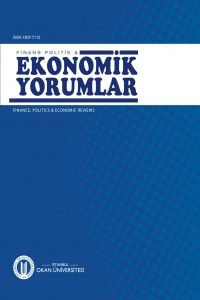İç Borçlanma, Enflasyon ve Ekonomik Büyüme: Türkiye için Ekonometrik Bir Uygulama (1980-2014)
İç borçlanma, enflasyon ve büyüme ilişkisi uzun süredir iktisat yazınını meşgul etmekte olan bir konu durumundadır. Bu çalışmada amaç, iç borçlanmanın, enflasyonun ve ekonomik büyüme oranlarının birbirlerini etkileyip etkilemediğini, etkilemişse ne yönde etkilediğini Türkiye özelinde test etmektir. Bu amaçla çalışmanın ampirik kısmında, 1980–2014 dönemine ait yıllık büyüme oranı, enflasyon oranı ile iç borç/GSYİH kullanılmıştır. Değişkenlere önce ADF ve PP durağanlık testi uygulanmıştır. Daha sonra değişkenler arasındaki nedenselliğin tespiti amacıyla “Toda-Yamamoto” nedensellik testi kullanılmıştır. Yapılan analiz sonucunda, enflasyon ile iç borç arasında çift yönlü, büyümeden enflasyona doğru ise tek yönlü nedensellik bulguları elde edilmiştir.
Anahtar Kelimeler:
İç Borçlanma, Enflasyon, Ekonomik Büyüme, Toda-YamamotoYöntemi.
Domestic Debt, Inflation, Economic Growth: An Econometric Application for Turkey (1980- 2014)
The relationship between domestic borrowing, inflation and growth is a longstanding issue in the literature of economy. The purpose of this study is to test whether domestic borrowing, inflation and the rate of economic growth influence each other, and if they are influenced in what way this happens in the case of Turkey. For this reason, annual growth rate, inflation rate and domestic debt/GDP, for the years 1980-2014, were used in the emprical part of the study. Initially, ADF and PP stability test was conducted in line with the variables. Furthermore, “Toda-Yamamoto” causality test was conducted to detect the causality between variables. The results of the study showed that there is a two way causality between domestic borrowing and inflation, and a one sided one from growth to inflation.
Keywords:
Domestic Debt, Inflation, Economic Growth, Toda-Yamamoto Method.,
___
- ABBAS, S. M. A. ve CHRISTENSEN, J. E., (2007), “The Role of Domestic Debt Markets in Economic Growth: An Empirical Investigation for Low Income Countries and Emerging Markets”, IMF Working Paper, 127.
- ADOFU, I. ve ABULA, M. (2010), “Domestic Debt and the Nigerian Economy”, Current Research Journal of Economic Theory, 2 (1), 22-26.
- AHMAD, M. J. vd., (2012), “Domestic Debt and Inflationary Effects: An Evidence from Pakistan”, International Journal of Humanities and Social Science, 2 (18), 256-263.
- AKDOĞAN, A. (1989), Kamu Maliyesi, Ankara: Gazi Kitabevi.
- AKUJUOBI, L. ( 2007), “Debt and Economic Development In Nigeria”, Journal of Research in National Development, 5 ( 2), 1-6.
- ALTAYLIGİL, Y. B. ve AKKAY, R. C. (2013), “The Effect of the Domestic Debt on the Financial Development: A Case Study for Turkey”, International Journal of Economics and Finance, 5 (5), 64-74.
- ALTINTAŞ, H. ve TABAN, S. (2010), “Türkiye’de İkiz Açık Sorunu ve Feldstein Horioka Hipotezi: ARDL Yaklaşımı ve Nedensellik Araştırması”, Küresel Krizler ve Ekonomik Yönetişim, Turgut Özal Uluslararası Ekonomi ve Siyaset Kongresi-I, Malatya: İnönü Üniversitesi, 1704-1734.
- ARSAN, Ü. (1970), “Kalkınan Ülkelerde Kamu Borçları”, Ankara Üniversitesi SBF Dergisi, 25 (3), 121-164. ATIQUE, R. ve MALİK, K. (2012), “Impact of Domestic and External Debt on the Economic Growth of Pakistan”, World Applied Sciences Journal, 20 (1), 120-129.
- AYTAÇ, D. ve SAĞLAM, M. (2014), “Kamu Açıkları, İç Borç ve Faiz Oranı İlişkisi: Türkiye Örneği”, Eskişehir Osmangazi Üniversitesi İİBF Dergisi, 9 (1), 131- 149.
- BABU, J. O. vd., (2015), “Effect of Domestic Debt on Economic Growth in the East African Community”, American Journal of Research Communication, 3 (9), 73-95.
- BAKARE, İ. A. vd., (2016), “Empirical Analysis of The Effects of Domestic Debt on Nigerian Economic Growth”, International Journal of Social Sciences and Humanities Reviews, 6 (1), 40- 50.
- BAYRAKTAR, Y. (2010), “İç Borçlanmanın Ekonomik ve Sosyal Etkileri: 1980 Sonrası Türkiye Deneyimi”, Erciyes Üniversitesi İktisadi ve İdari Bilimler Fakültesi Dergisi, 34: 285-313.
- BDDK (2010), Krizden İstikrara Türkiye Tecrübesi, Çalışma Tebliği, Ankara.
- BON, N. V. (2015), “The Relationship between Public Debt and Inflation in Developing Countries: Empirical Evidence Based on Difference Panel GMM”, Asian Journal of Empirical Research, 5 (9), 128-142.
- CORDELLA, T., RICCI, A., ARRANZ, R. (2005), “Debt Overhang or Debt Irrelevance? Revisiting the Debt-Growth Link”, IMF Working Paper, 05, 223.
- ÇELİKÖZ, Y. S. ve YUKACI, İ. (2016), “Konsolide Bütçe Açıkları ve İç Borç-Dış Borç İlişkisi: Türkiye Örneği”, İnsan ve Toplum Bilimleri Araştırmaları Dergisi, 5 (3), 478 -504.
- ÇEVİK, N. K. ve CURAL, M. (2013), “İç Borçlanma, Dış Borçlanma ve Ekonomik Büyüme Arasında Nedensellik İlişkisi:1989-2012 Dönemi Türkiye Örneği”, Maliye Dergisi, 165, 115-139.
- ÇETİN, A. (2005), “Kamu Borçlarının Makroekonomik Etkileri: Ampirik Bir Analiz”, Atatürk Üniversitesi İktisadi ve İdari Bilimler Dergisi, 19 (1), 67-79.
- ÇİÇEK, H. vd., (2010), “Bir Maliye Politikası Aracı Olarak Borçlanma ve Ekonomik Büyüme İlişkisi: Türkiye Örneği (1990– 2009), C.Ü. İktisadi ve İdari Bilimler Dergisi, 11 (1), 141-156.
- ÇOBAN, O., DOĞANALP, N. ve UYSAL, D. (2008), “Türkiye’de Kamu İç Borçlanmasının Makroekonomik Etkileri”, Selçuk Üniversitesi Sosyal Bilimler Enstitüsü Dergisi, 20, 245-255.
- DEMİR, M. ve SEVER, E. (2008), “Kamu İç Borçlanmasının Büyüme, Faiz ve Enflasyon Oranı Üzerindeki Etkileri”, Elektronik Sosyal Bilimler Dergisi, 7 (25), 170-196
- ISSN: 1307-7112
- Başlangıç: 1963
- Yayıncı: İstanbul Okan Üniversitesi
Sayıdaki Diğer Makaleler
Bölgesel Kalkınmada Dış TicaretSektörünün Rolü ve Sorunları: BatıAkdeniz Bölgesi Örneği
Yoksulluğu Önlemeye Yönelik Sosyal Bütçe Uygulamaları ve Türkiye Açısından Değerlendirilmesi
Kâmil TÜĞEN, Abdulkerim EROĞLU
İç Borçlanma, Enflasyon ve Ekonomik Büyüme: Türkiye için Ekonometrik Bir Uygulama (1980-2014)
